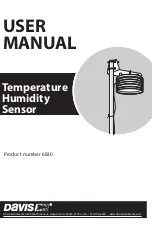
Parameter description:
P1: Setpoint / DeltaW for control circuit 2
Adjusting the setpoint of control circuit 2.
If A5=1, the setpoints for control circuit 1 and 2 are linked with one another via switching difference
DeltaW, which can be adjusted with P1. (operation with DeltaW)
The following applies: setpoint thermostat 2 = setpoint control circuit 1 + delta W2.
This difference can take positive or negative values. Thus, a leading or following contact can be
realised.
P2: Hysteresis contact K1
P3: Hysteresis contact K2
The hysteresis can be set symmetrically or one-sided at the setpoint (see A40, A41).
At one-sided setting, the hysteresis works downward with heating contact and upward with cooling
contact. At symmetrical hysteresis, half of the hysteresis’ value is effective below and half of the
value above the switching point (see fig. 1 and 2).
Fig. 1:
Heating controller, one-sided hysteresis
Fig. 2:
Cooling controller, symmetrical
hysteresis
P4: Control range limitation – minimum setpoint
P5: Control range limitation – maximum setpoint
The adjustment range of the setpoint can be limited in both directions. This is to prevent the end
user of a unit from setting inadmissible or dangerous setpoints.
P6: Actual value correction
This parameter allows the correction of actual value deviations caused for example by sensor
tolerances or extremely long sensor lines. The regulation measure value is increased or decreased
by the here adjusted value.
P11: Employment point of the ramp phase
Before reaching the point of ramp employment the controller works at full heating/cooling power.
After reaching the point of ramp employment regulation to reach the setpoint is effected by help of
a ramp profile. The ramp is ascending at heating function with employment points below the
setpoint. At cooling function it is falling with employment points above the setpoint.
After the setpoint is reached, the ramp function becomes inactive, unless the temperature exceeds
the point of ramp employment again in either direction, due to external influences (see fig. 3+4).
Please note that the ramp function is deactivated, if the actual value is inside the ramp range
during switching-on.
Changes of ramp parameters are not considered once the ramp has started, but become effective
only thereafter. In the case of activated ramp function, there are two employment points for the
ramp possible (see parameter A6):
Summary of Contents for ST70-31.03
Page 2: ......






























